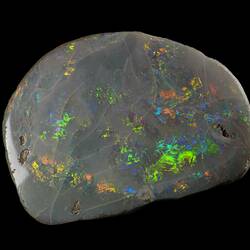Summary
Opal is found around the world but around 95% of precious opal today comes from Australia, largely from Coober Pedy in South Australia. This opal came from Lightning Ridge, New South Wales.
Opal is a form of silica so is made up of silicon and oxygen. Though it shares its chemical formula with quartz, the atoms within it are arranged very differently giving it different physical properties. Opal has what is called an amorphous structure, meaning it is not crystalline and is therefore classified as a mineraloid rather than a mineral. Though not crystalline there is structure within opal. There are four different forms but usually the atoms arrange into spheres which pack around each other. When the spheres are about the same size light diffracts through them and produces many beautiful colours, including blues, reds, greens and yellows. This is called opalescence.
Opals are considered gemstones and have been used in jewellery for thousands of years. The word opal is thought to have come either from the Latin "opalus", meaning "precious stone" or from the Sanskrit "upala" meaning "stone".
Specimen Details
-
Number Of Specimens
1
-
Specimen Nature
Nature: Cabochon, Form: Gemstone(s)
-
Species
-
Variety
-
Group
-
Class
-
Category
-
Scientific Group
-
Discipline
-
Collecting Areas
-
Type of Item
Geospatial Information
-
Country
-
State
-
Town



